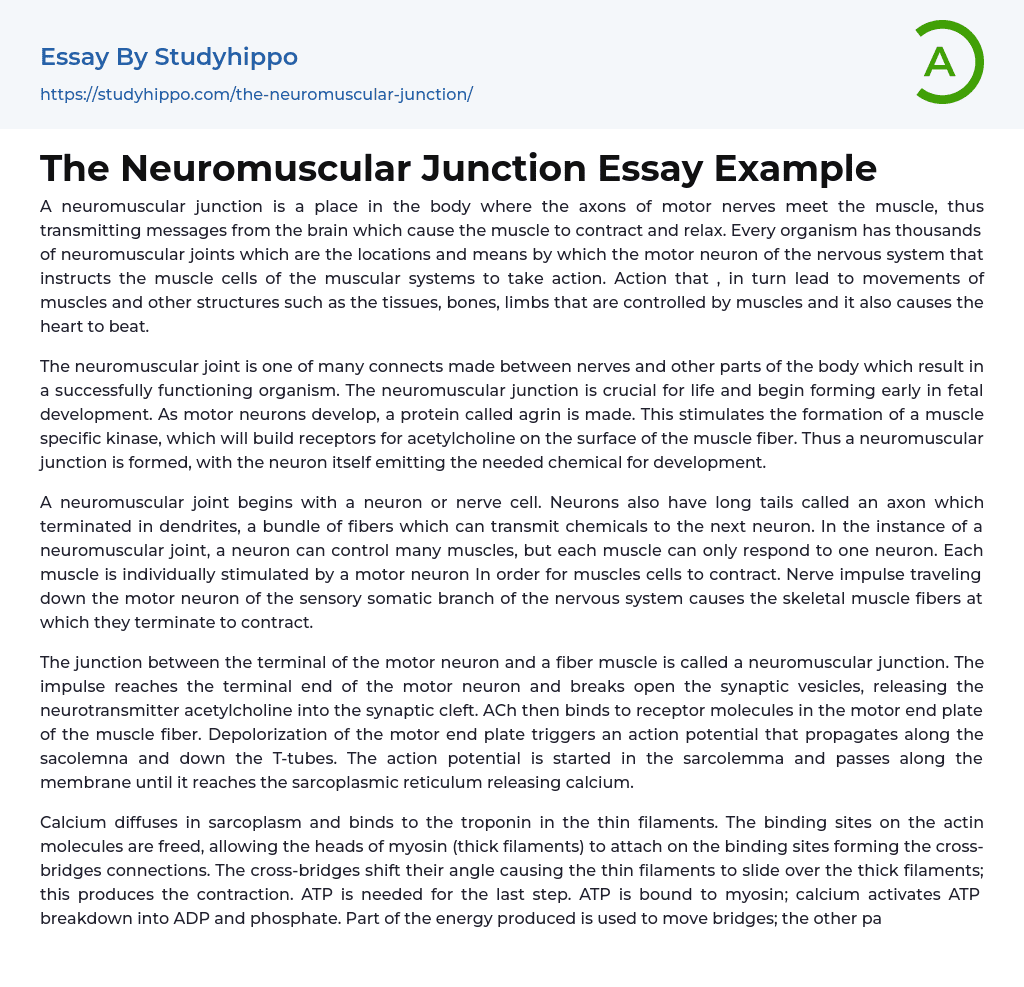A neuromuscular junction is a place in the body where the axons of motor nerves meet the muscle, thus transmitting messages from the brain which cause the muscle to contract and relax. Every organism has thousands of neuromuscular joints which are the locations and means by which the motor neuron of the nervous system that instructs the muscle cells of the muscular systems to take action. Action that , in turn lead to movements of muscles and other structures such as the tissues, bones, limbs that are controlled by muscles and it also causes the heart to beat.
The neuromuscular joint is one of many connects made between nerves and other parts of the body which result in a successfully functioning organism. The neuromuscular junction is crucial for life and begin forming early in fetal development. As mo
...tor neurons develop, a protein called agrin is made. This stimulates the formation of a muscle specific kinase, which will build receptors for acetylcholine on the surface of the muscle fiber. Thus a neuromuscular junction is formed, with the neuron itself emitting the needed chemical for development.
A neuromuscular joint begins with a neuron or nerve cell. Neurons also have long tails called an axon which terminated in dendrites, a bundle of fibers which can transmit chemicals to the next neuron. In the instance of a neuromuscular joint, a neuron can control many muscles, but each muscle can only respond to one neuron. Each muscle is individually stimulated by a motor neuron In order for muscles cells to contract. Nerve impulse traveling down the motor neuron of the sensory somatic branch of the nervous system causes th
skeletal muscle fibers at which they terminate to contract.
The junction between the terminal of the motor neuron and a fiber muscle is called a neuromuscular junction. The impulse reaches the terminal end of the motor neuron and breaks open the synaptic vesicles, releasing the neurotransmitter acetylcholine into the synaptic cleft. ACh then binds to receptor molecules in the motor end plate of the muscle fiber. Depolorization of the motor end plate triggers an action potential that propagates along the sacolemna and down the T-tubes. The action potential is started in the sarcolemma and passes along the membrane until it reaches the sarcoplasmic reticulum releasing calcium.
Calcium diffuses in sarcoplasm and binds to the troponin in the thin filaments. The binding sites on the actin molecules are freed, allowing the heads of myosin (thick filaments) to attach on the binding sites forming the cross-bridges connections. The cross-bridges shift their angle causing the thin filaments to slide over the thick filaments; this produces the contraction. ATP is needed for the last step. ATP is bound to myosin; calcium activates ATP breakdown into ADP and phosphate. Part of the energy produced is used to move bridges; the other part is released as heat, increasing the body temperature.
More ATP breaks the bond between thick and thin filaments in the cross bridge; calcium ions which trigger a contraction of the muscles cells returns to thesarcoplasmic reticulum and the thin filaments return to their original position, closing off the binding site to cross bridges and causing the muscle to relax. Several conditions can cause malfunctions at the site of a neuromuscular junction, leading to loss of muscle control. Ultimately,
lack of muscle control can cause death if it is severe, because the body's largest muscle, the heart, could stop beating.
The most common such illness is myasthenia gravis, which is caused by an autoimmune reaction against acetylcholine receptors. As a result, motor neurons cannot transmit the chemical to the muscles, which will cause muscle weakness and an ultimate loss of control. Myasthenia gravis tends to be more concentrated along skeletal muscles, and is especially noticeable in the face. Additionally, some toxins such as botulinum will inhibit the release of acetylcholine, which will lead to muscle paralysis.
- Microbiology essays
- Bacteria essays
- Cell essays
- Enzyme essays
- Photosynthesis essays
- Plant essays
- Natural Selection essays
- Protein essays
- Viruses essays
- Cell Membrane essays
- Human essays
- Stem Cell essays
- Breeding essays
- Biotechnology essays
- Cystic Fibrosis essays
- Tree essays
- Seed essays
- Coronavirus essays
- Zika Virus essays
- Action Potential essays
- Blood essays
- Body essays
- Brain essays
- Childbirth essays
- Eye essays
- Glucose essays
- Heart essays
- Human Physiology essays
- Immune System essays
- Kidney essays
- Muscle essays
- Nervous System essays
- Neuron essays
- Poison essays
- Puberty essays
- Sense essays
- Skeleton essays
- Skin essays
- Agriculture essays
- Albert einstein essays
- Animals essays
- Archaeology essays
- Bear essays
- Biology essays
- Birds essays
- Butterfly essays
- Cat essays
- Charles Darwin essays
- Chemistry essays
- Dinosaur essays




